Dreadlocks have evolved from a cultural tradition into a versatile and stylish hair choice for children, offering endless possibilities for creative expression while maintaining healthy hair.
Parents today are discovering that dreadlocks can be both practical and adorable, requiring less daily maintenance than many other hairstyles while allowing kids to showcase their unique personalities.
The beauty of children’s dreadlocks lies in their adaptability—from playful ponytails and colorful beads to elegant updos and fun shapes that make every day feel special.
Whether you’re considering starter locs for your toddler or looking to refresh your child’s existing dreadlock style, the options available today blend traditional techniques with modern trends that kids absolutely love.
This comprehensive guide to 30 Latest Dreadlock Styles for Kids That Are Adorable will walk you through the most popular and age-appropriate dreadlock styles, complete with maintenance tips, styling ideas, and creative variations that will have your little one excited about their hair.
From simple everyday looks to special occasion styles, you’ll discover how dreadlocks can be transformed into everything from adorable pigtails to sophisticated buns, each style designed with your child’s comfort and confidence in mind.
Get ready to explore a world where culture meets creativity, where practicality meets playfulness, and where your child’s hair becomes a beautiful canvas for self-expression that they’ll be proud to show off at school, playdates, and family gatherings.
Contents
- 1 1. Classic Short Starter Locs
- 2 2. High Ponytail Locs with Beads
- 3 3. Two-Strand Twist Locs
- 4 4. Side-Swept Locs with Hair Accessories
- 5 5. Faux Hawk Loc Style
- 6 6. Braided Loc Ponytail
- 7 7. Top Knot Locs
- 8 8. Half-Up Half-Down Locs
- 9 9. Loc Buns with Twisted Front
- 10 10. Colored Tips on Locs
- 11 11. Spiral Loc Curls
- 12 12. Asymmetrical Loc Bob
- 13 13. Loc Pigtails with Wraps
- 14 14. Crown Braid with Loose Locs
- 15 15. Mini Buns Throughout
- 16 16. Mohawk Loc Style with Shaved Sides
- 17 17. Loc Space Buns
- 18 18. Waterfall Loc Style
- 19 19. Loc Accessories with Metal Cuffs
- 20 20. Side Cornrows Leading to Loose Locs
- 21 21. Butterfly Loc Style
- 22 22. Loc Mohawk Braid
- 23 23. Low Twisted Bun
- 24 24. Zigzag Part with Double Ponytails
- 25 25. Loc Headband Style
- 26 26. Criss-Cross Ponytail Locs
- 27 27. Bantu Knot Locs
- 28 28. Graduated Length Locs with Layers
- 29 29. Wrapped Loc Ponytail with Design
- 30 30. Natural Freeform Locs
- 31 Conclusion
1. Classic Short Starter Locs
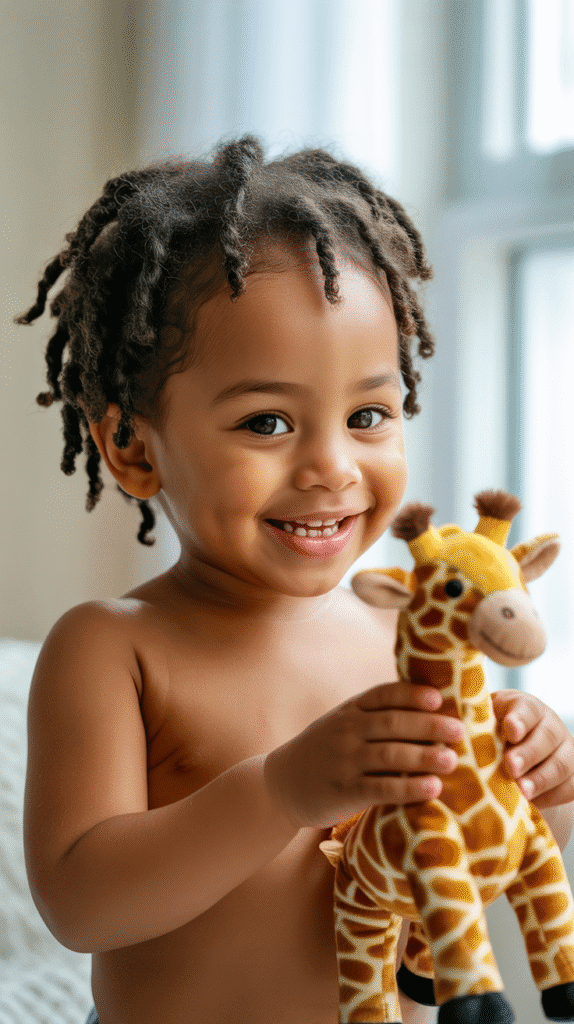
Short starter locs are the perfect introduction to the dreadlock journey for young children, offering a low-maintenance foundation that grows beautifully over time.
This style works exceptionally well for toddlers and young kids who are just beginning their loc journey, providing a neat and manageable look that parents appreciate.
- The installation process typically involves sectioning the hair into small, uniform parts and then twisting or coiling each section to form the base of the dreadlocks.
- This style usually ranges from 1 to 3 inches in length, making it ideal for active children who need hair that stays out of their face during play.
- Starter locs require minimal styling products, often just a light moisturizing spray and occasional palm rolling to maintain their shape.
- The beauty of this style lies in its simplicity and the exciting transformation journey ahead as the locs begin to mature and develop their own unique texture.
- Parents should expect a maintenance routine every 2-3 weeks, which includes retwisting the roots and ensuring the scalp remains clean and moisturized.
2. High Ponytail Locs with Beads
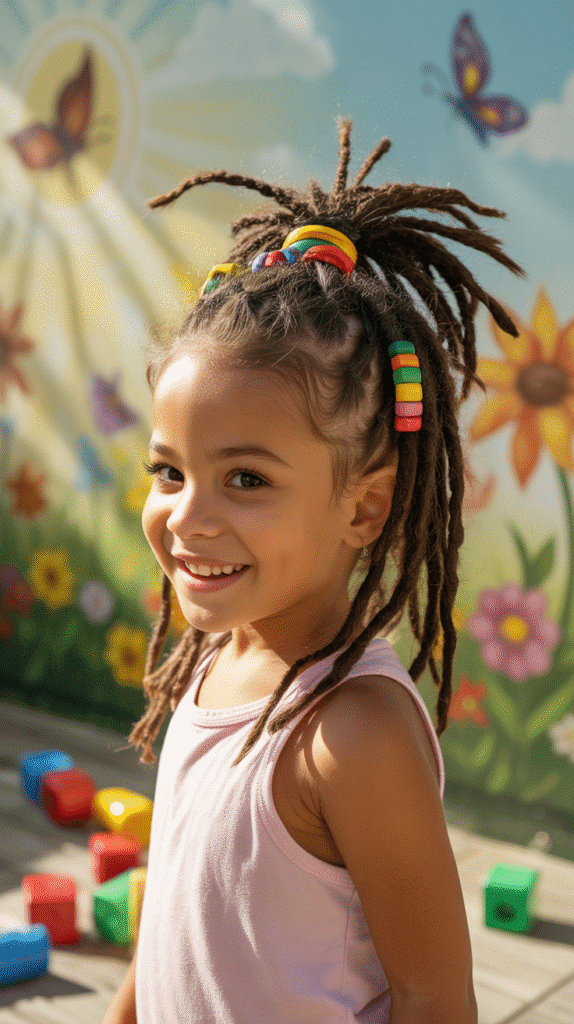
The high ponytail loc style brings together practicality and playfulness, creating an elevated look that keeps hair secure while adding a touch of personality through colorful beads.
This versatile style has become increasingly popular among school-age children who want a polished yet fun appearance.
- Gathering all the locs to the crown of the head creates an elongated silhouette that complements most face shapes and adds a sense of confidence to your child’s appearance.
- Colorful beads can be threaded onto individual locs throughout the ponytail, allowing children to express their favorite colors or coordinate with their outfits.
- This style keeps locs completely away from the face and neck, making it ideal for sports activities, hot weather, and focused classroom time.
- The high placement of the ponytail can be adjusted to different heights depending on preference, from a sleek top-of-head position to a slightly lower crown placement.
- To prevent tension and breakage, use soft fabric hair ties or loc-friendly bands that won’t snag or pull at the roots.
- The beads add a delightful sound element that many children love, creating a gentle clicking noise as they move throughout their day.
3. Two-Strand Twist Locs
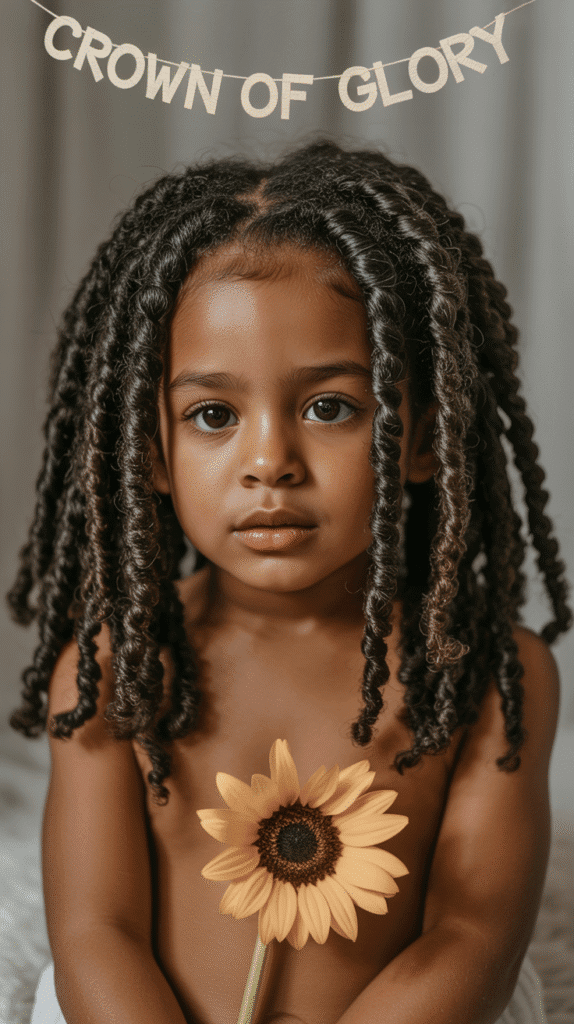
Two-strand twist locs offer a refined texture that adds dimension and visual interest to children’s dreadlocks while promoting healthy hair growth and loc development.
This technique creates a rope-like appearance that many parents and kids find particularly attractive during the early stages of the loc journey.
- Each dreadlock is created by dividing a section of hair into two parts and twisting them around each other in a continuous spiral motion from root to tip.
- This method is gentler on young, tender scalps compared to some other loc techniques, making it an excellent choice for children with sensitive skin.
- The twists naturally encourage the hair to loc over time while maintaining a more defined and uniform appearance throughout the maturation process.
- Two-strand twists can be styled in various ways including updos, ponytails, or left hanging loose for a flowing, dynamic look.
- The technique works beautifully on all hair textures, though it’s particularly effective on type 3 and type 4 hair patterns.
- Maintenance involves retwisting the roots every 3-4 weeks and keeping the hair moisturized with lightweight oils or sprays designed for locs.
4. Side-Swept Locs with Hair Accessories

Side-swept locs create an asymmetrical elegance that’s both age-appropriate and fashion-forward, perfect for children who love a style that feels special and unique.
This look can be dressed up or down depending on the accessories chosen, making it suitable for both everyday wear and special occasions.
- All the locs are gently brushed or gathered to one side of the head, creating a cascading effect that draws attention and frames the face beautifully.
- Decorative hair accessories such as colorful clips, flowers, ribbons, or jeweled pins can be strategically placed to secure the style and add personal flair.
- This asymmetrical style works particularly well for children with medium to long locs who want to showcase their length in a creative way.
- The side-swept look can be adjusted throughout the day without completely restyling, making it practical for active children.
- For added security during active play, a few bobby pins designed for textured hair can be discreetly placed to keep the locs in position.
- This style photograph beautifully and has become a favorite for school pictures, birthday parties, and family celebrations.
5. Faux Hawk Loc Style
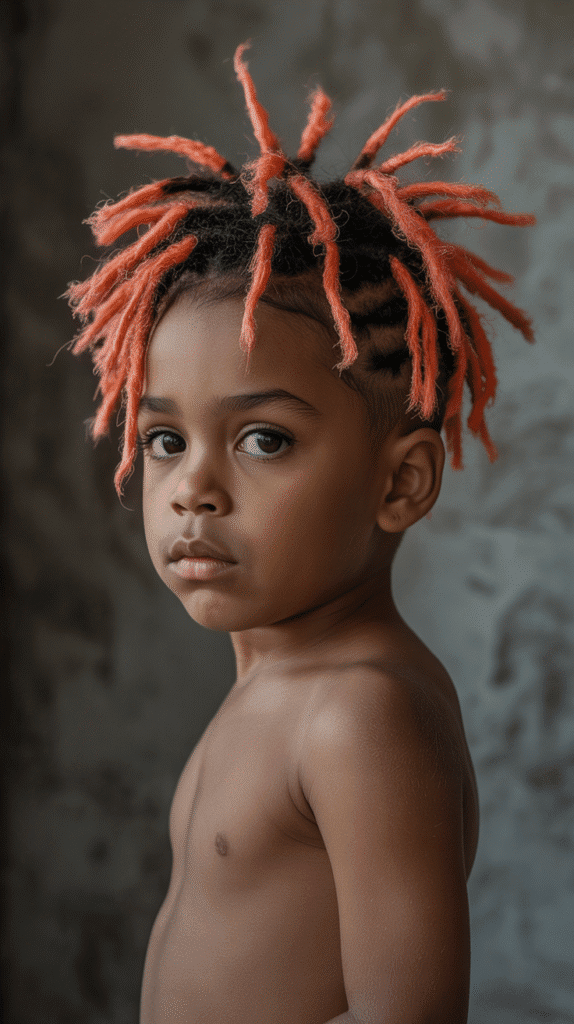
The faux hawk loc style brings an edgy, modern twist to children’s dreadlocks, creating a bold statement that’s surprisingly versatile and fun for kids with adventurous spirits.
This style has gained tremendous popularity among both boys and girls who want to stand out with a confident, creative look.
- The sides of the head are smoothed down or styled flat while the center locs are gathered and styled upward to create a mohawk-inspired ridge running from front to back.
- This dramatic style can be adjusted in height and width depending on the child’s preference and the length of their locs.
- Strong-hold gel or loc styling cream designed for children can be used on the sides to maintain the sleek appearance throughout the day.
- The center locs can be left loose and spiky, twisted together for added texture, or even braided for a unique variation.
- This style works exceptionally well for special occasions, performances, or when your child wants to feel extra confident and expressive.
- Despite its bold appearance, the faux hawk is relatively easy to create and can be styled back down into a more conventional look when needed.
6. Braided Loc Ponytail
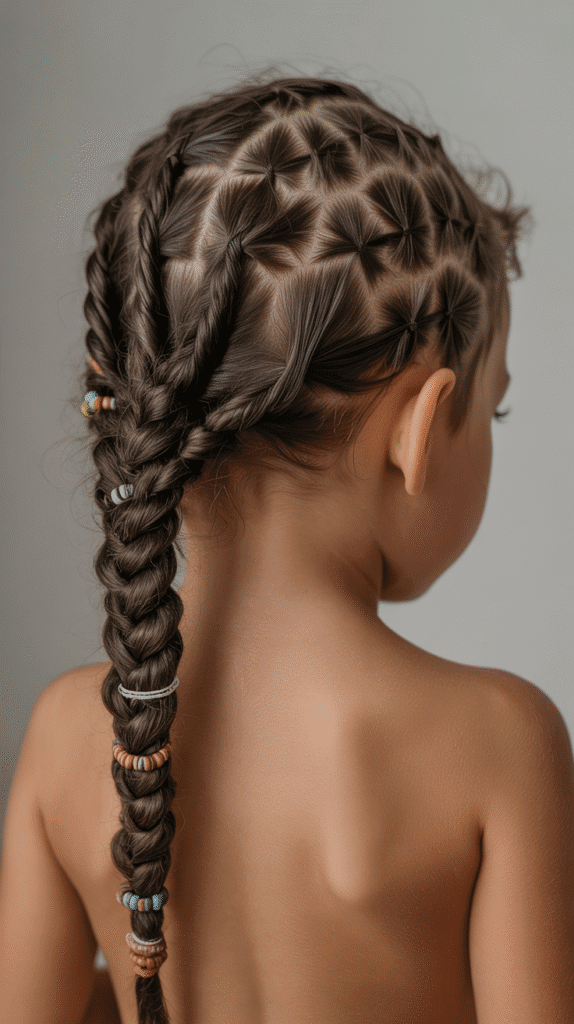
The braided loc ponytail combines two beloved styling techniques into one stunning look that showcases both the beauty of dreadlocks and the intricacy of braiding.
This sophisticated style elevates a simple ponytail into something truly special that children feel excited to wear.
- After gathering the locs into a ponytail at the desired height, several locs are braided together to create a thick, textured braid that extends down the length.
- The braiding technique can vary from a traditional three-strand braid to more complex patterns like fishtail or rope braids, depending on the child’s age and patience level.
- This style effectively manages longer locs while creating visual interest that goes beyond a standard ponytail.
- The braided portion keeps locs organized and tangle-free, making it an excellent choice for overnight wear or extended wear throughout busy days.
- Small elastics can be added at the bottom of the braid to secure it, and decorative beads or cuffs can be incorporated along the braid for added personality.
- This style demonstrates the versatility of locs and helps children understand that their dreadlocks can be manipulated and styled in countless creative ways.
7. Top Knot Locs
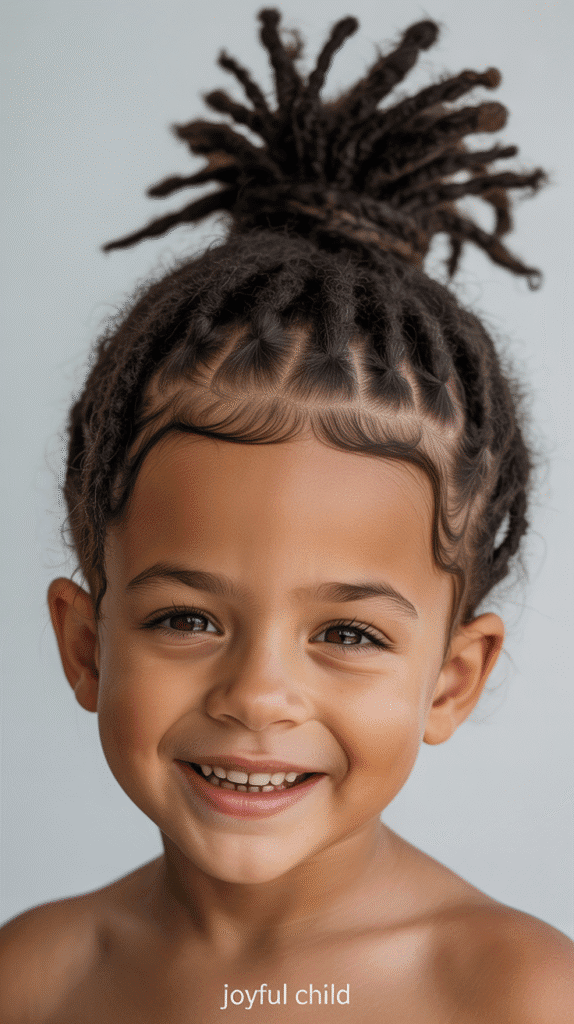
The top knot loc style creates a playful, ballet-inspired look that’s both practical and absolutely adorable on children of all ages.
This elevated bun sits prominently at the top of the head, giving kids a sense of height and sophistication they often love.
- All the locs are gathered at the crown or slightly forward on the top of the head, then wrapped and secured into a rounded bun shape.
- The positioning of the knot can be adjusted based on preference, from directly on top for a dramatic effect to slightly back for a more relaxed appearance.
- This style keeps all hair completely secured and out of the way, making it ideal for dance classes, gymnastics, swimming, and other physical activities.
- A few shorter locs or baby hairs can be left out around the hairline to soften the look and add a touch of casual charm.
- The top knot works well with locs of various lengths, though medium to long locs create the most substantial and visually striking buns.
- Hair accessories like decorative pins, colorful scrunchies, or wrap-around bands can be added to personalize the style and make it feel special.
8. Half-Up Half-Down Locs
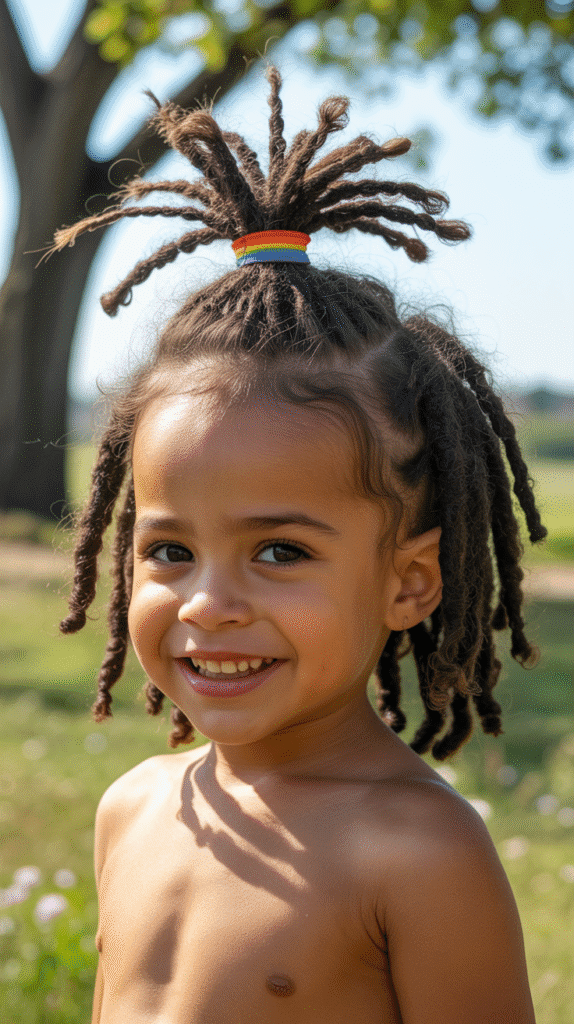
The half-up half-down loc style strikes the perfect balance between secured and free-flowing hair, offering a versatile look that’s comfortable and stylish for everyday wear.
This classic style has remained popular because it genuinely works for almost every occasion and face shape.
- The top half of the locs are gathered and secured at the crown or mid-head level while the remaining locs hang freely down the back and sides.
- This style keeps hair away from the face during activities while allowing children to enjoy the movement and length of their locs.
- The secured top portion can be styled as a ponytail, bun, or even braided for added variation and personal expression.
- This look is incredibly versatile and appropriate for school, play dates, family outings, and more formal events with simple adjustments.
- The half-up section can be accessorized with clips, bands, or beads, while the lower section can also be decorated or left natural.
- This style is particularly forgiving and can be easily adjusted or touched up throughout the day without requiring complete restyling.
9. Loc Buns with Twisted Front
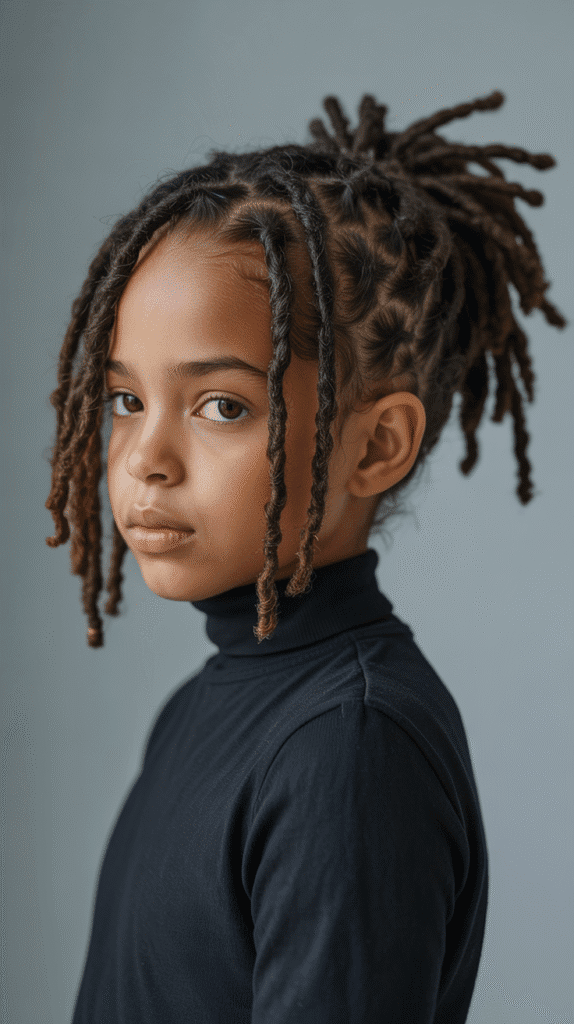
Loc buns with a twisted front section create an elegant, polished appearance that adds sophistication to children’s dreadlocks while maintaining youthful charm.
This style combines structural elements with creative detailing that makes it stand out from standard bun styles.
- The front section of locs is divided and twisted along the hairline, creating a frame-like border that adds dimension and interest to the overall style.
- The remaining locs are then gathered and formed into one or two buns at the back or sides of the head, depending on personal preference.
- This style is particularly beautiful for special occasions like weddings, holiday celebrations, or formal family photographs.
- The twisted front can follow the natural hairline curve or be arranged in creative patterns for added artistic expression.
- Using a light styling cream or gel on the twisted sections helps maintain definition and keeps them smooth throughout the day.
- This look works wonderfully for children with medium to long locs who want a style that feels grown-up yet remains age-appropriate.
10. Colored Tips on Locs
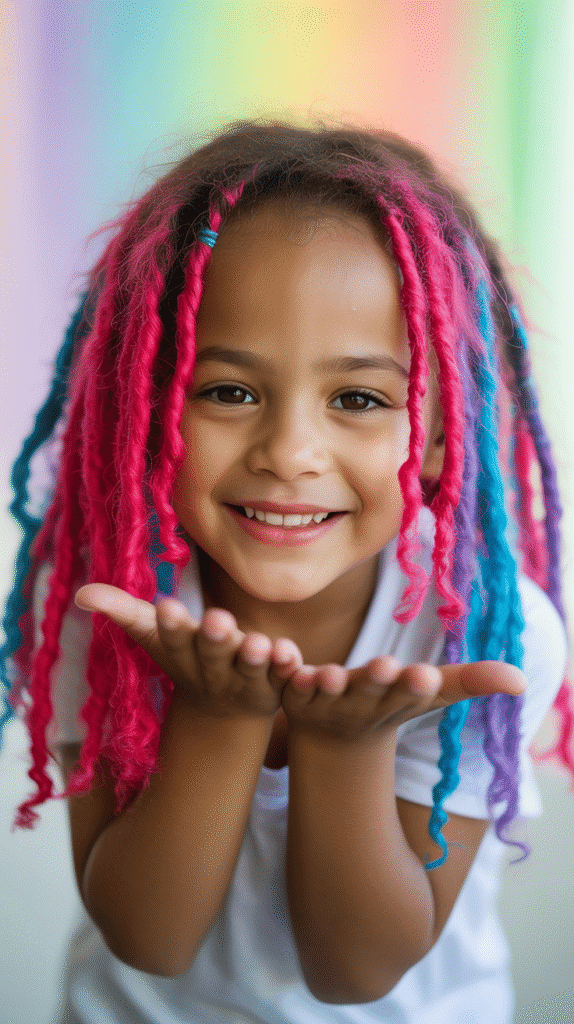
Adding colored tips to children’s dreadlocks introduces a vibrant, temporary pop of color that allows for creative expression without permanent commitment.
This trend has become increasingly popular as parents seek ways to let their kids experiment with color in a controlled, hair-healthy manner.
- Temporary hair color, washable hair chalk, or colored hair wax can be applied to the bottom few inches of locs, creating an ombré or dip-dyed effect.
- Popular color choices for kids include bright shades like pink, blue, purple, green, and rainbow combinations that reflect their playful personalities.
- This styling option is perfect for special events, school spirit days, birthday parties, or simply when your child wants to try something new and exciting.
- The temporary nature of these color products means children can change their look frequently without any damage to their natural hair or locs.
- Application is simple and can be a fun bonding activity between parent and child, allowing kids to be involved in their styling choices.
- Washable colors typically last until the next shampoo, making them ideal for experimenting with different looks without long-term commitment.
11. Spiral Loc Curls
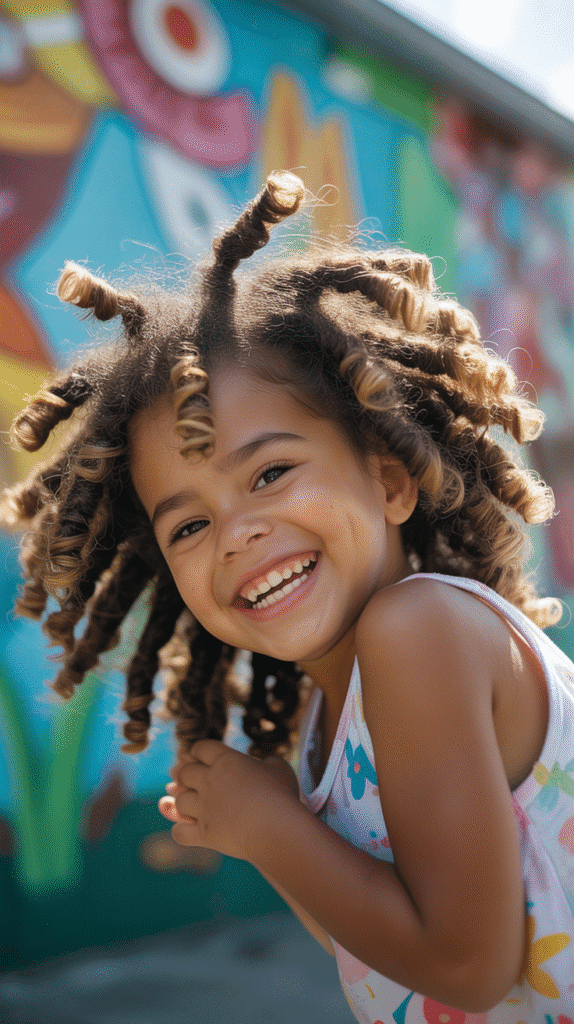
Spiral loc curls transform straight or loosely textured dreadlocks into bouncy, springy ringlets that add volume and a playful dimension to children’s hairstyles.
This technique creates a temporary textural change that kids often find delightfully different from their everyday loc appearance.
- Perm rods, flexi rods, or pipe cleaners can be wrapped around individual locs while damp, then allowed to dry completely to set the spiral curl pattern.
- The size of the rods used determines the tightness of the curls, with smaller rods creating tighter spirals and larger ones producing looser, bouncier curls.
- This style adds significant volume and creates a completely different silhouette that makes children feel like they have a brand new hairstyle.
- Spiral curls can last several days to a week depending on the child’s hair texture, activity level, and how well the style is protected at night.
- Light moisture and gentle handling help maintain the curl definition without causing the locs to frizz or lose their spiral shape.
- This temporary styling technique is excellent for special occasions and helps children appreciate the versatility of their dreadlocks.
12. Asymmetrical Loc Bob

The asymmetrical loc bob creates a modern, fashion-forward look that’s surprisingly chic on children while remaining practical and easy to maintain.
This style works particularly well for kids who want something different that still feels sophisticated and current.
- Locs are cut or styled to create an angled bob shape where one side is noticeably longer than the other, creating visual interest through asymmetry.
- The shorter side typically falls around ear length while the longer side extends to chin or shoulder level, depending on personal preference.
- This geometric style frames the face beautifully and has a contemporary edge that appeals to fashion-conscious children and parents.
- The asymmetrical cut allows for various styling options, including tucking the shorter side behind the ear or adding accessories to accentuate the angle.
- This look requires less maintenance than longer locs while still providing enough length for creative styling when desired.
- Regular trims help maintain the shape and keep the style looking intentional and polished.
13. Loc Pigtails with Wraps
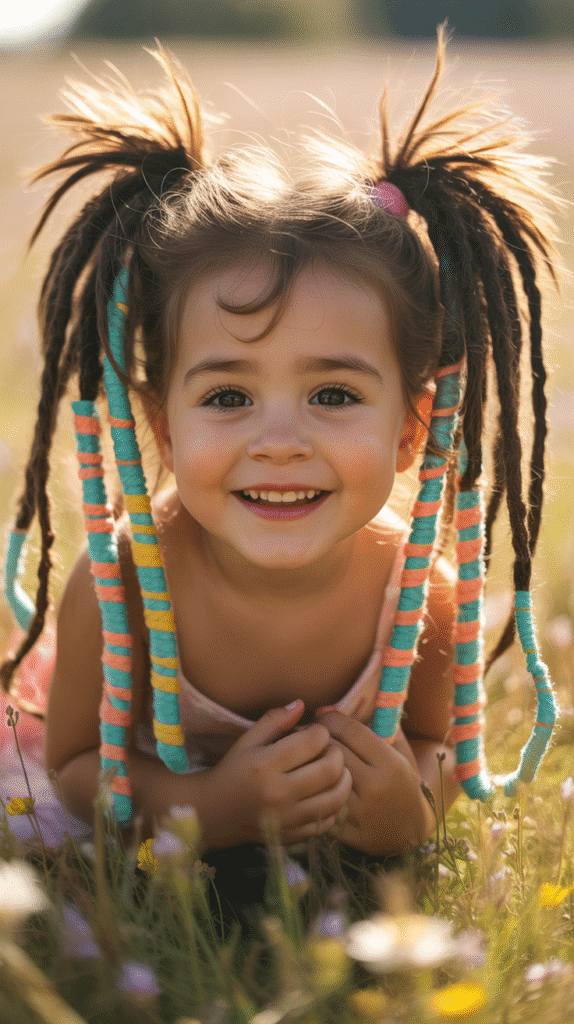
Loc pigtails with decorative wraps bring a traditional, youthful style into the world of dreadlocks with added flair through colorful thread or yarn wrapping.
This adorable style has timeless appeal while incorporating modern decorative elements that make it uniquely special.
- The locs are parted down the middle and gathered into two ponytails positioned at equal heights on either side of the head.
- Colorful embroidery thread, yarn, or specialized hair wrapping cord is then wound around sections of the pigtails, creating vibrant patterns and designs.
- The wrapping technique can cover entire pigtails or just accent portions, allowing for customization based on the child’s preferences and desired look.
- This style is particularly popular for younger children as it has a sweet, innocent quality while incorporating elements of cultural tradition.
- The wraps add an extra layer of personality and can be coordinated with favorite colors, school colors, or seasonal themes.
- Pigtails keep hair neatly divided and managed, making this an excellent choice for active children who need a secure style.
14. Crown Braid with Loose Locs
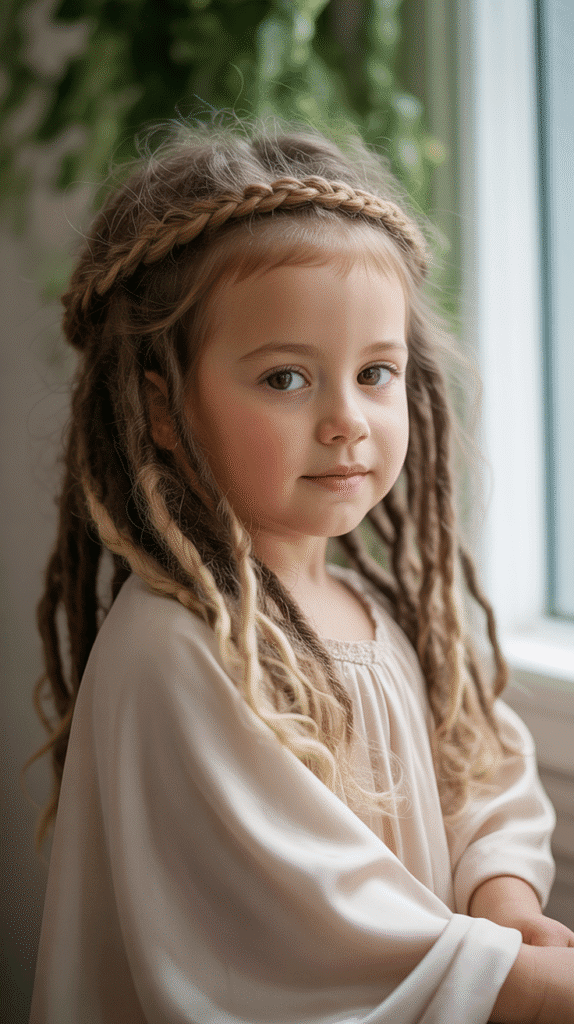
The crown braid with loose locs creates a princess-like appearance that children absolutely adore, combining structured braiding around the hairline with the free-flowing beauty of dreadlocks.
This romantic style balances elegance with practicality in a way that works for both special occasions and everyday wear.
- A section of locs around the hairline is braided in a continuous pattern that circles the head like a crown or halo.
- The remaining locs hang freely from the crown down, creating a beautiful contrast between the structured braid and flowing locks.
- This style effectively frames the face while keeping hair secure around the forehead and temples where it’s most likely to cause distraction.
- The crown braid can incorporate accessories like small flowers, pearls, or decorative pins for added elegance during special events.
- This look works beautifully for children with medium to long locs who want to feel special and princess-like.
- The style can last several days with proper nighttime care, making it practical despite its elaborate appearance.
15. Mini Buns Throughout
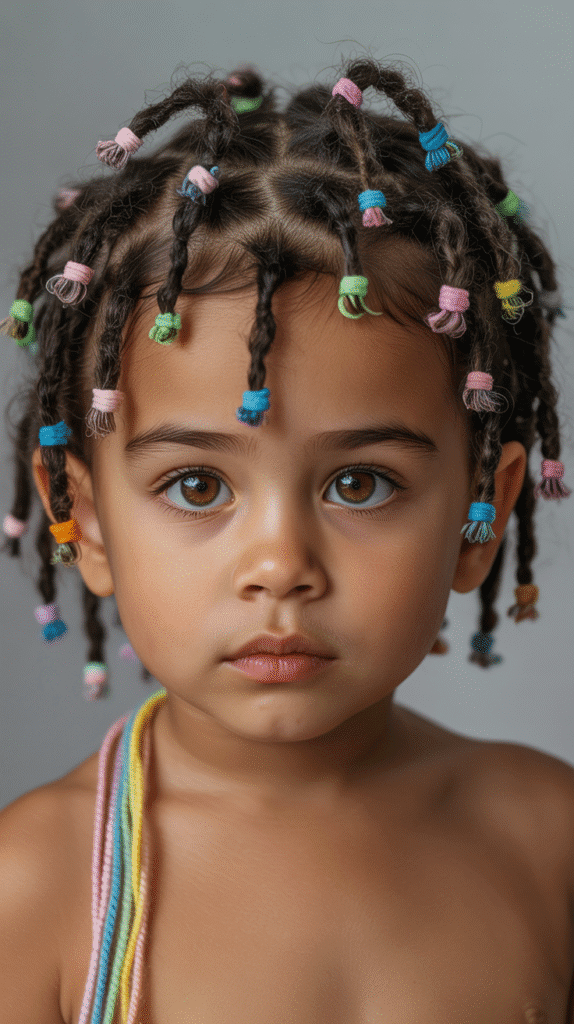
Multiple mini buns scattered throughout the head create a playful, unique style that’s utterly charming on children with dreadlocks.
This whimsical look has gained popularity for its creativity and the way it keeps longer locs organized while looking absolutely adorable.
- Small sections of locs are gathered and twisted into miniature buns positioned throughout the head in organized patterns or random placements.
- The number of mini buns can vary from just a few to a dozen or more, depending on the density of locs and desired effect.
- This style transforms the head into a textured, dimensional landscape that photographs beautifully and draws positive attention.
- Each mini bun can be secured with small elastics and optionally decorated with tiny accessories or beads for extra personality.
- The style is practical for keeping locs contained while still allowing for creative expression and playful styling.
- Mini buns can be positioned in rows, scattered randomly, or arranged in patterns that reflect your child’s creativity.
16. Mohawk Loc Style with Shaved Sides
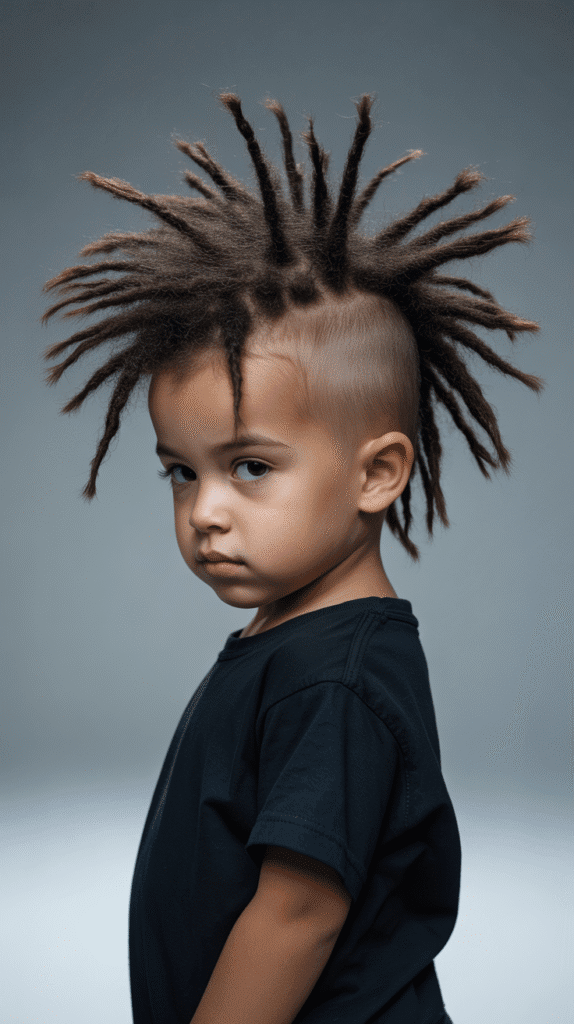
The mohawk loc style with shaved sides creates a bold, statement-making look that’s increasingly popular among children who want to express their individuality with confidence.
This edgy style combines the cultural significance of locs with contemporary barbering techniques.
- The sides and back of the head are kept very short or shaved while the locs remain on a strip running from the forehead to the back of the head.
- This creates a dramatic contrast between the textured locs and the clean, shaved sections, resulting in a striking visual impact.
- The remaining locs can be styled upward, to the side, or even left hanging depending on their length and the child’s preference.
- This style requires regular maintenance visits to keep the shaved portions neat and maintain the defined shape.
- The mohawk strip can vary in width from narrow for a more dramatic effect to wider for a more substantial presence.
- This look has become popular across genders and works particularly well for children with strong personalities and confident self-expression.
17. Loc Space Buns
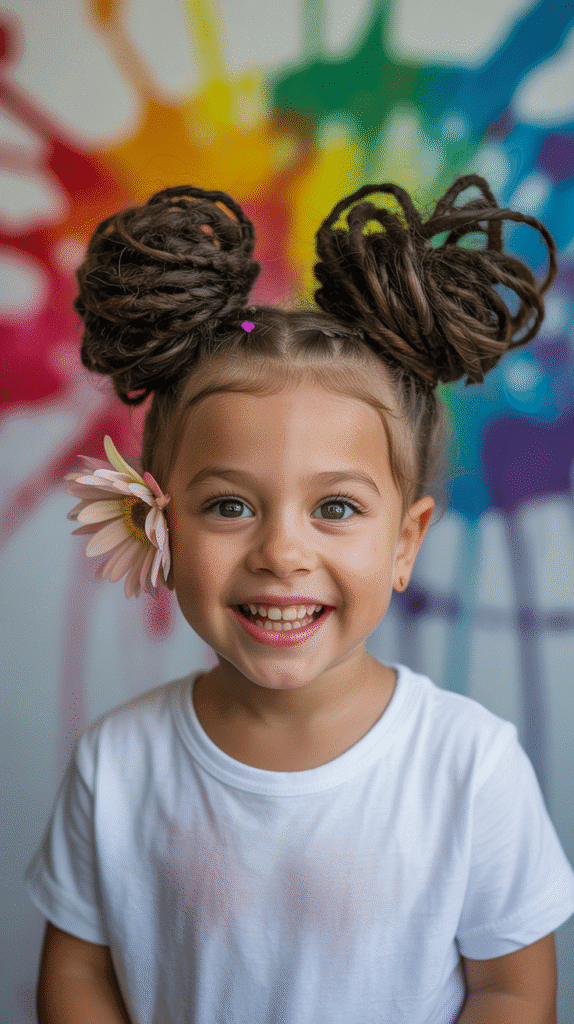
Loc space buns create a fun, youthful style that’s reminiscent of popular culture characters while being perfectly practical for active children.
This playful style has become a favorite among kids who love a look that feels both trendy and unique.
- The hair is parted down the middle and each half is gathered high on either side of the head, then twisted into round bun shapes positioned like “space buns.”
- The high placement and symmetrical positioning create a distinctive silhouette that’s immediately recognizable and utterly charming.
- This style works exceptionally well for children with medium to long locs that can create substantial, visible buns.
- Space buns keep all hair completely secured and off the neck, making them ideal for hot weather, sports, and active play.
- The buns can be decorated with colorful scrunchies, glitter accessories, or left simple for a cleaner aesthetic.
- This style has cross-generational appeal and works for various occasions from casual everyday wear to costume parties and special events.
18. Waterfall Loc Style
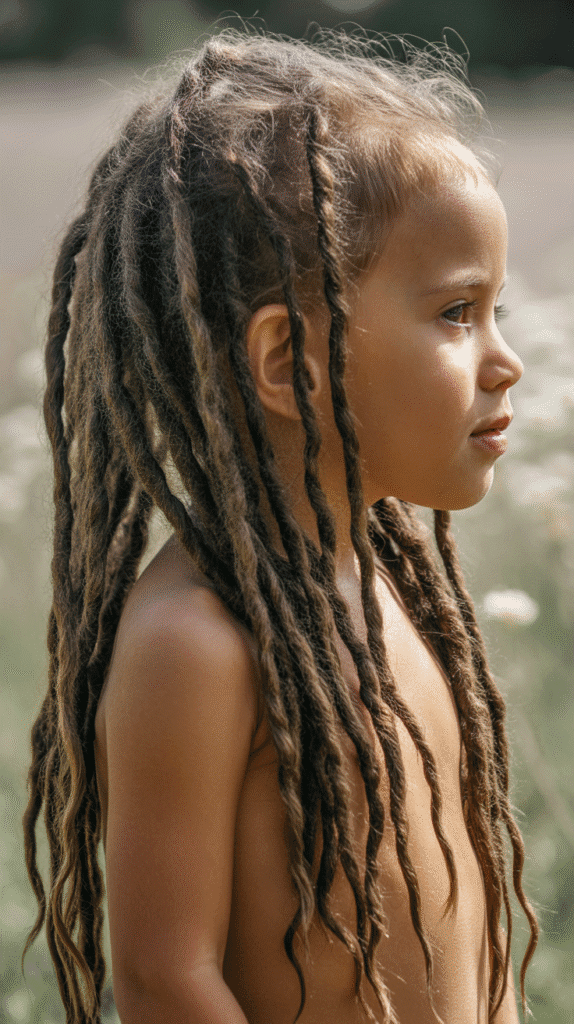
The waterfall loc style creates flowing, cascading sections that have a romantic, ethereal quality perfect for children who love styles with movement and grace.
This technique adds dimension and visual interest through strategic layering and positioning.
- Locs are arranged in sections that cascade over each other in a waterfall-like pattern, creating depth and a sense of flowing movement.
- The technique involves strategically positioning and securing certain locs while allowing others to flow freely over and around them.
- This style works particularly beautifully for children with longer locs where the cascading effect can be fully appreciated.
- Small clear elastics or bobby pins can be discreetly used to maintain the waterfall structure while keeping the overall appearance natural and flowing.
- The style has a sophisticated elegance that makes it suitable for formal occasions like recitals, ceremonies, or special family celebrations.
- Despite its elaborate appearance, the waterfall style can be maintained throughout the day with minimal adjustment needed.
19. Loc Accessories with Metal Cuffs
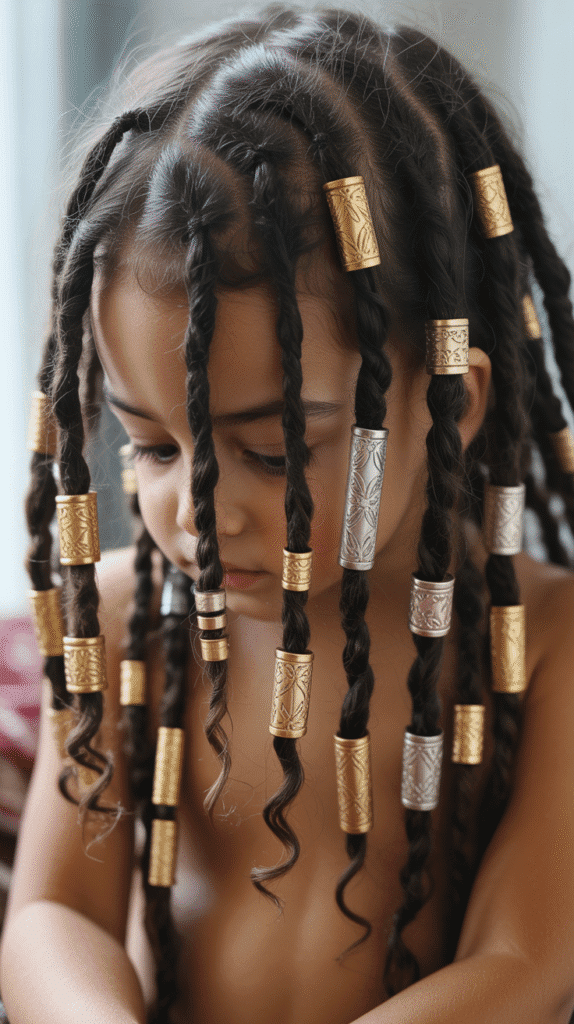
Metal cuffs and decorative rings add an element of style and personality to children’s dreadlocks, transforming simple locs into a customized, jewelry-adorned hairstyle.
These accessories have become increasingly popular as they’re easy to use and create instant visual impact.
- Metal cuffs in various sizes and designs slide onto individual locs at different positions, creating points of interest throughout the hairstyle.
- The cuffs come in numerous styles including plain metallic finishes, decorative patterns, colored enamel, and designs featuring symbols or shapes.
- Placement can be strategic with cuffs positioned near the ends, at mid-length, or clustered together for concentrated decorative impact.
- These accessories are reusable and can be mixed and matched to create different looks, making them a practical investment for versatile styling.
- Cuffs add weight and visual texture to locs while being easy enough for children to help select and position themselves.
- The metallic elements catch light beautifully and add a sophisticated touch that works for both casual and dressy occasions.
20. Side Cornrows Leading to Loose Locs

Side cornrows leading to loose locs combine two beloved styling techniques into one cohesive look that’s both structured and free-flowing.
This hybrid style has gained popularity for its ability to keep hair secure in the front while showcasing the beauty of locs in the back.
- Cornrows are braided along one or both sides of the head, starting at the hairline and extending toward the back or crown area.
- The remaining locs that aren’t incorporated into the cornrows hang freely, creating a beautiful contrast between braided and loose textures.
- This style is particularly practical as it keeps hair away from the face while allowing children to enjoy the movement of their locs.
- The cornrow sections can follow straight lines, curved patterns, or even zigzag designs for added creativity and personal expression.
- This look requires professional or skilled installation but can last one to two weeks with proper maintenance and nighttime care.
- The style works beautifully for school, sports, and special occasions, making it a versatile choice for active children.
21. Butterfly Loc Style
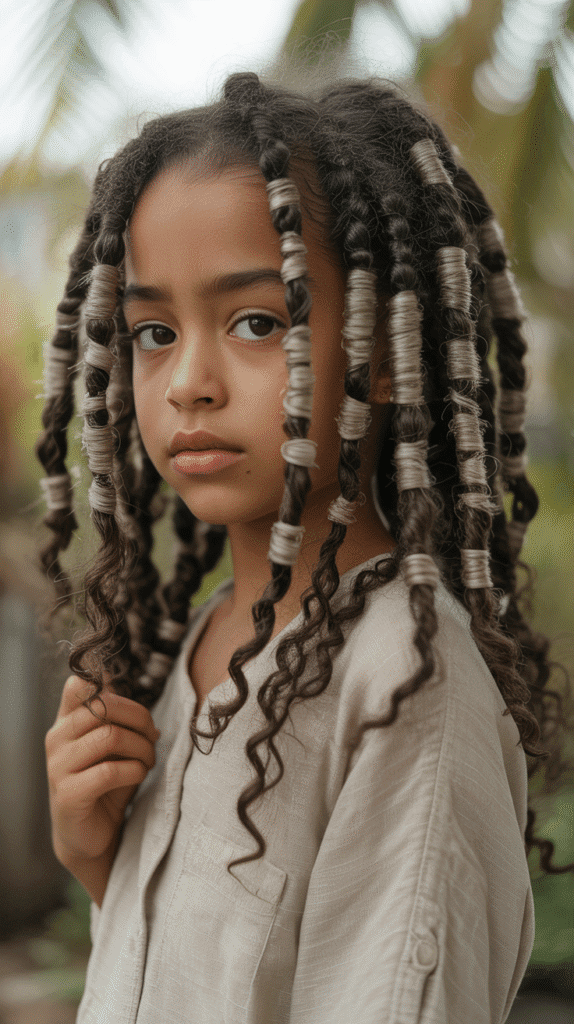
The butterfly loc style represents a newer technique that creates a unique, textured appearance distinct from traditional dreadlocks while maintaining the loc aesthetic.
This method has gained attention for its softer, more delicate appearance that many parents and children find appealing.
- Butterfly locs are created using a wrapping technique with hair extensions that creates a distressed, bohemian texture with visible loops and a less uniform appearance.
- This style tends to be lighter in weight than traditional locs, making it more comfortable for children with sensitive scalps or those new to protective styling.
- The installation process is generally faster than traditional loc methods, and the style can be removed more easily when desired.
- Butterfly locs have a romantic, whimsical quality with their slightly messy, textured appearance that feels artistic and intentional.
- The style works well for children wanting the loc aesthetic without the long-term commitment of traditional locs.
- Maintenance involves keeping the scalp moisturized and avoiding excessive manipulation, with the style typically lasting 4-8 weeks.
22. Loc Mohawk Braid
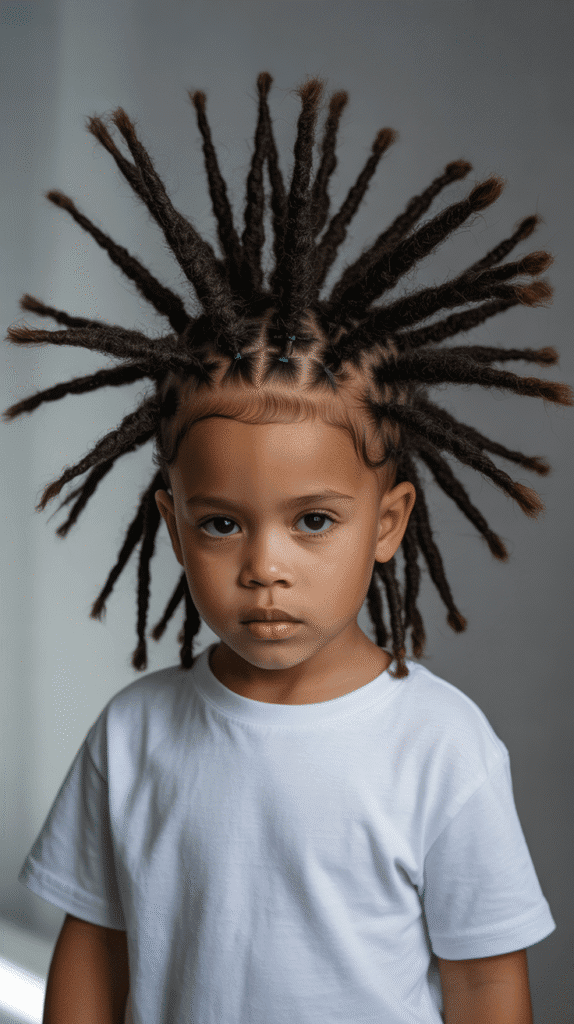
The loc mohawk braid combines the boldness of a mohawk silhouette with the intricate beauty of braiding, creating a show-stopping style that’s perfect for children who love to stand out.
This advanced styling technique transforms locs into a stunning centerpiece hairstyle.
- The locs are gathered into a strip down the center of the head and braided together in a cornrow or French braid style that stands elevated from the scalp.
- The sides are either smoothed down completely or styled with smaller cornrows that complement the central mohawk braid.
- This elevated braid creates dramatic height and dimension that’s visually striking from every angle.
- The style can be customized with different braiding techniques including Dutch braids for more height or fishtail patterns for added texture.
- Small accessories like beads or metallic cuffs can be incorporated into the mohawk braid for additional personality and flair.
- This look works wonderfully for performances, special events, or whenever your child wants to make a memorable impression.
23. Low Twisted Bun
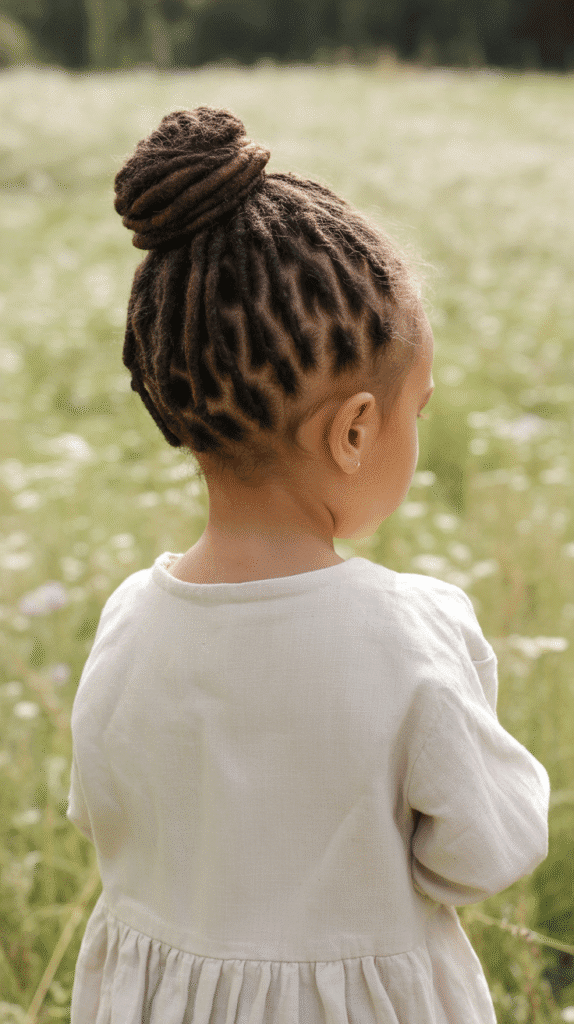
The low twisted bun offers a sophisticated, ballet-inspired elegance that’s beautifully age-appropriate for children with dreadlocks.
This classic style has timeless appeal and works seamlessly for both everyday activities and formal occasions.
- All locs are gathered at the nape of the neck and twisted together before being wrapped into a neat, rounded bun shape.
- The low placement keeps the bun secure and comfortable, avoiding any tension at the crown that higher styles might create.
- This style has a polished, refined appearance that works exceptionally well for school, formal events, and professional settings like performances or presentations.
- A few smaller locs or wisps can be left out to frame the face softly, preventing the style from looking too severe or strict.
- The twisted bun technique creates texture within the bun itself, adding visual interest while maintaining an overall neat appearance.
- This look is comfortable enough to sleep in and can last multiple days, making it practical for busy families.
24. Zigzag Part with Double Ponytails
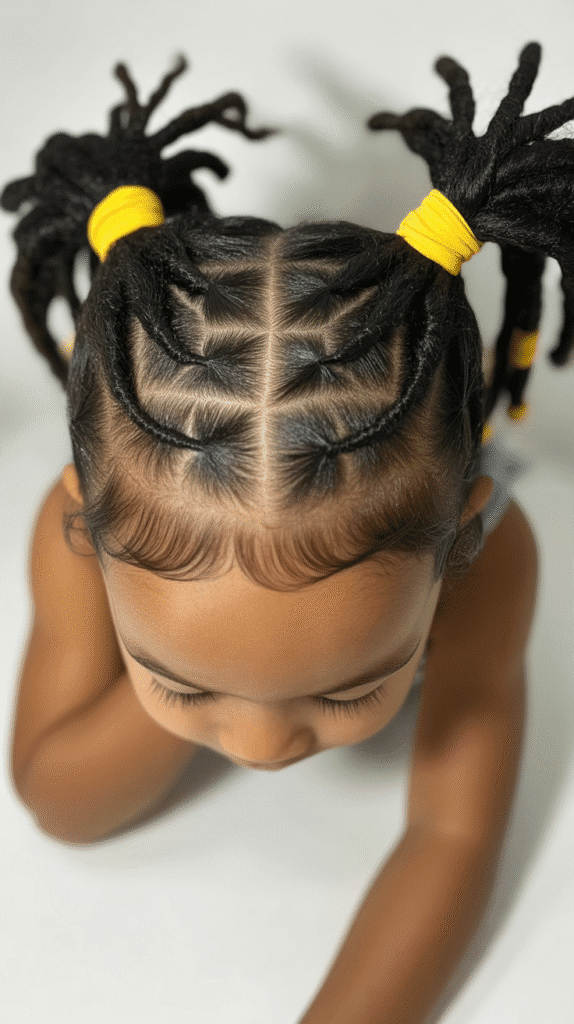
The zigzag part with double ponytails adds a playful geometric element to a classic children’s style, making it feel fresh and contemporary.
This fun variation on traditional pigtails has become popular for its ability to add personality through a simple parting technique.
- Instead of a straight center part, the hair is parted in a zigzag pattern from forehead to nape, creating visual interest before the hair is even styled.
- Each side of the zigzag part is then gathered into a ponytail, creating double ponytails with an unexpected twist.
- The zigzag can be subtle and gentle or more dramatic and pronounced depending on the child’s preference and the stylist’s creativity.
- This style keeps hair neatly divided and manageable while adding a fun, youthful element that children often request repeatedly.
- Colorful elastics or decorative accessories can be added to the ponytails to enhance the playful nature of the style.
- The zigzag parting technique works well with locs of various lengths and adds minimal time to the styling process.
25. Loc Headband Style
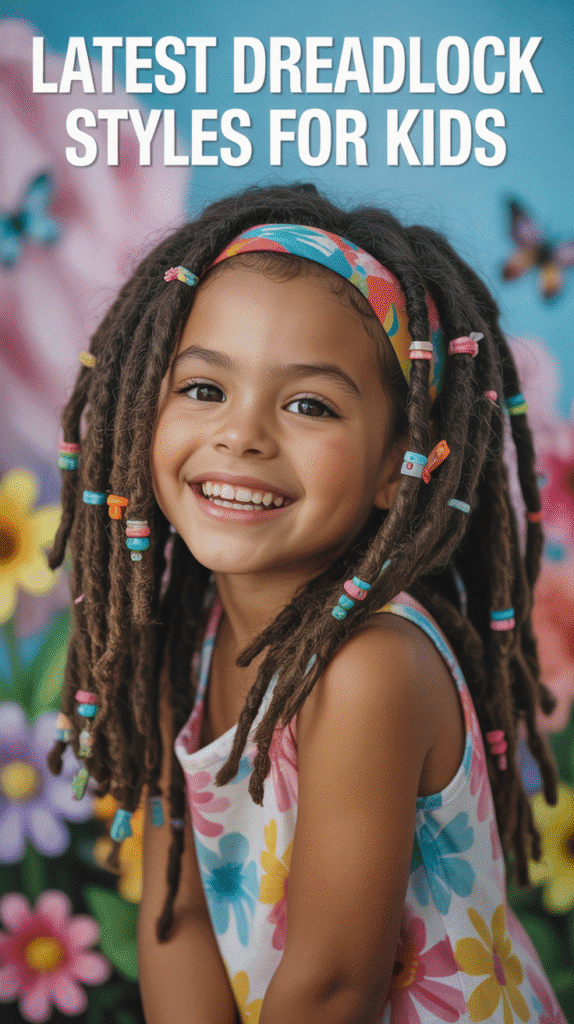
The loc headband style creates the illusion of a headband made entirely from the child’s own locs, offering a creative way to keep hair off the face while showcasing styling versatility.
This technique has gained popularity for its unique appearance and practical function.
- A section of locs from one side is brought across the front of the hairline to the opposite side, creating a band-like border across the forehead.
- This “headband” of locs can be a single thick section or multiple thinner locs twisted or braided together for varied effects.
- The remaining locs hang freely behind the headband section, creating a beautiful contrast between the structured front and flowing back.
- Bobby pins or small elastics discreetly secure the headband section, keeping it in place throughout active days.
- This style effectively keeps hair out of the face without requiring actual accessories, making it perfect for children who dislike wearing headbands.
- The loc headband can be positioned at different heights on the forehead to create slightly different looks and accommodate various face shapes.
26. Criss-Cross Ponytail Locs
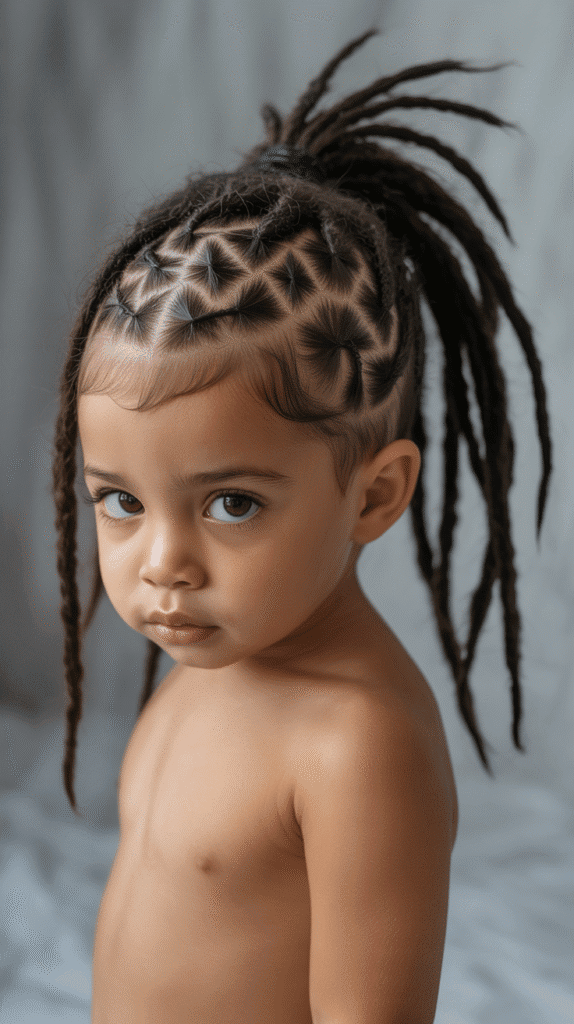
The criss-cross ponytail loc style introduces an eye-catching geometric pattern that transforms a simple ponytail into something truly special and unique.
This innovative styling technique has become a favorite for children who want their hairstyle to reflect creativity and modern trends.
- Sections of locs are crossed over each other in an X or lattice pattern before being gathered into a ponytail, creating a woven appearance at the base.
- The criss-cross pattern can be created with just two sections for simplicity or multiple sections for a more intricate, basket-weave effect.
- This technique adds visual interest to the front and sides of the head while keeping the ponytail functionality that children and parents appreciate.
- The crossed sections can be secured with small elastics at intersection points to maintain the pattern throughout the day.
- Once gathered into the ponytail, the locs can hang freely, be braided, or styled with accessories depending on the occasion.
- This style works particularly well for medium to long locs where the criss-cross pattern can be clearly seen and appreciated.
27. Bantu Knot Locs
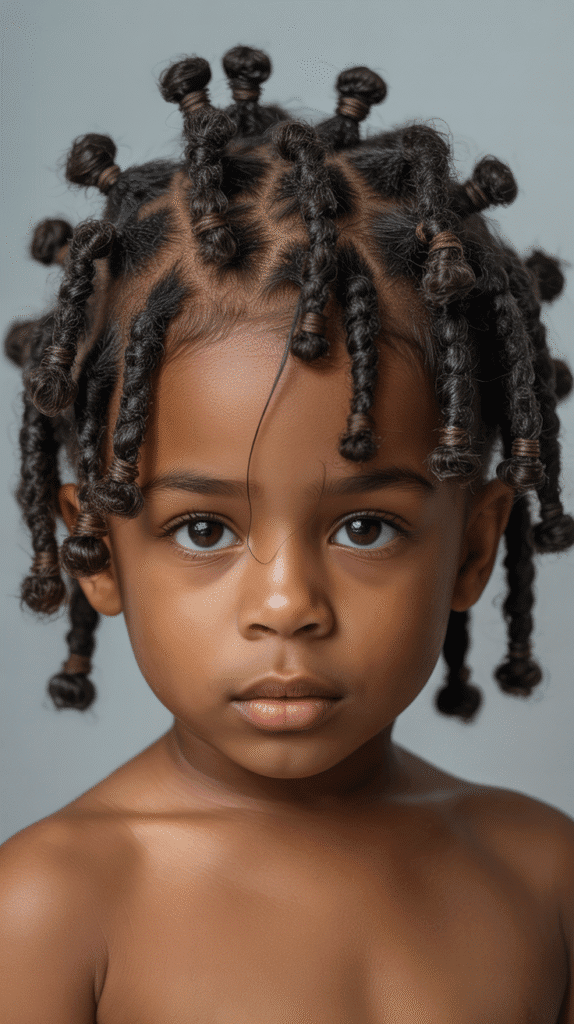
Bantu knot locs adapt the traditional Bantu knot technique for dreadlocks, creating a series of small, coiled buns throughout the head that are both culturally significant and absolutely adorable on children.
This protective style has deep cultural roots while being perfectly suited for modern kids.
- Individual locs or small groups of locs are twisted tightly and then wrapped around themselves to create small, knot-like coils that sit close to the scalp.
- The knots can cover the entire head or be positioned in specific patterns, combining Bantu knots with loose locs for varied styling.
- This technique is excellent for stretching locs and creating texture, and when unraveled after a few days, it produces beautiful spiral curls.
- Bantu knots keep locs completely secured and protected, making them ideal for nighttime wear or as a daytime style that requires zero maintenance.
- The knots create a unique, textured appearance that’s visually interesting and showcases the versatility of dreadlocks.
- This style works well for all loc lengths but is particularly striking with medium-length locs that create substantial, visible knots.
28. Graduated Length Locs with Layers
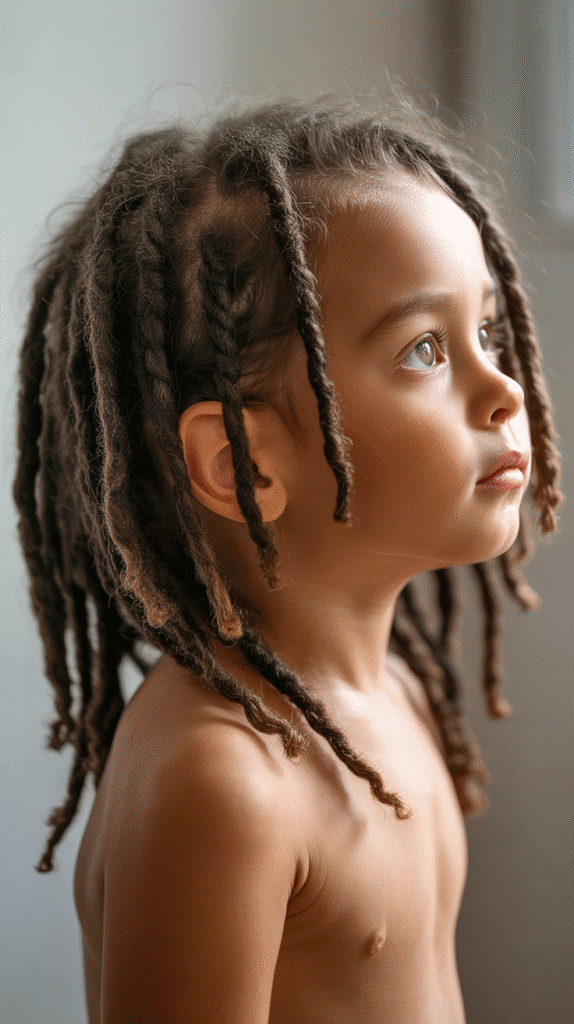
Graduated length locs with layers create dimension and movement through strategic cutting that gives dreadlocks a styled, intentional appearance.
This modern approach to loc maintenance has transformed how many people view the aesthetic possibilities of children’s dreadlocks.
- Locs are cut at varying lengths to create layers that frame the face and add body to the overall hairstyle.
- The graduated approach means locs are typically shorter in the front and gradually longer toward the back, creating a flattering silhouette.
- Layering removes excess weight from longer locs, making them easier to manage and style while adding bounce and movement.
- This cutting technique works beautifully for children whose locs have reached considerable length and could benefit from shape and structure.
- The layers can be subtle for a natural appearance or more dramatic for a bold, fashion-forward statement.
- Regular maintenance trims keep the graduated shape looking intentional and polished rather than uneven or neglected.
29. Wrapped Loc Ponytail with Design
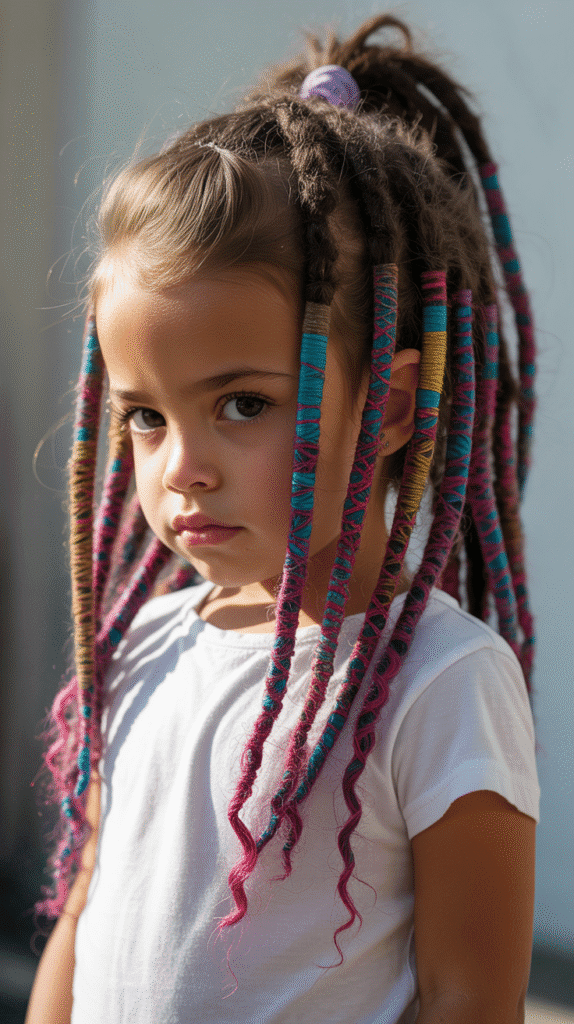
The wrapped loc ponytail with design elevates a standard ponytail through decorative wrapping techniques that create patterns and visual interest.
This artistic approach has become increasingly popular for special occasions and children who love personalized, unique styling.
- After gathering locs into a ponytail, colored thread, yarn, or specialized wrapping material is wound around the base and length in deliberate patterns.
- The wrapping can create stripes, spirals, color blocks, or geometric designs that showcase creativity and personal style preferences.
- Multiple colors can be incorporated to create rainbow effects, ombré transitions, or patterns that match favorite colors or team spirit.
- The wrapped sections add structure and visual weight to the ponytail while protecting the locs from environmental elements.
- This technique allows for seasonal styling, such as holiday colors, school colors, or colors representing special events and celebrations.
- The wrapping process can be a bonding activity between parent and child, allowing kids to be involved in designing their own unique look.
30. Natural Freeform Locs
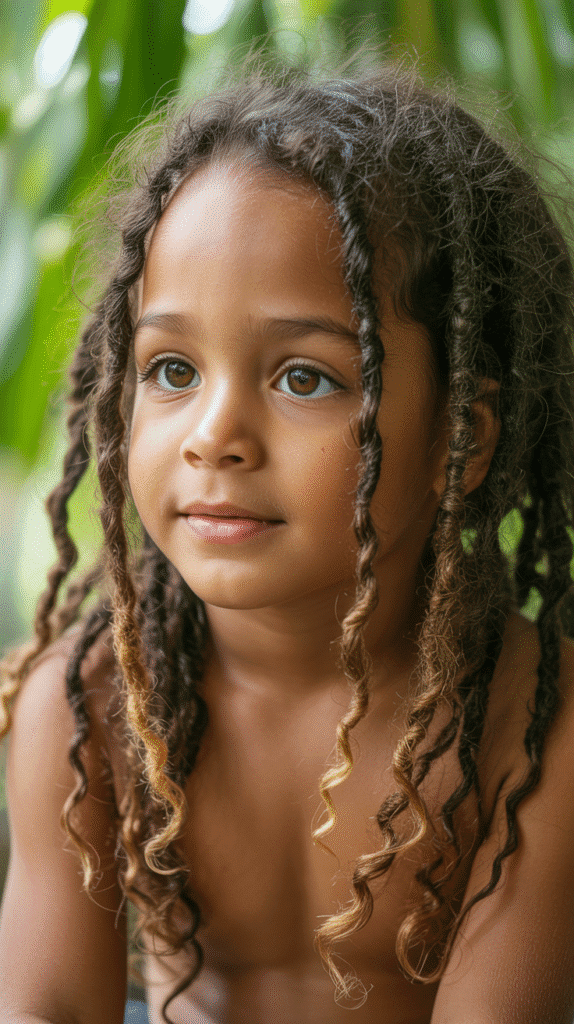
Natural freeform locs represent an organic approach where locs are allowed to form and develop with minimal manipulation, creating a unique, individualized appearance that celebrates natural hair texture.
This method has gained appreciation for its low-maintenance philosophy and authentic aesthetic.
- Freeform locs develop naturally through washing and separating without the use of retwisting, palm rolling, or other manipulation techniques.
- Each loc forms according to the hair’s natural sectioning and growth pattern, resulting in locs of varying sizes and shapes that are completely unique to the individual.
- This approach requires patience as locs take time to mature and develop their character, but the result is deeply personal and distinctive.
- Maintenance focuses on keeping the scalp clean and healthy while separating locs at the roots to prevent unwanted joining or congos forming.
- Freeform locs have an organic, artistic quality that appeals to families who appreciate natural aesthetics and minimal intervention.
- This style works for children whose parents prefer a hands-off approach to hair care while still maintaining healthy, beautiful locs.
Conclusion
The journey through these 30 Latest Dreadlock Styles for Kids That Are Adorable demonstrates that children’s dreadlocks offer far more versatility, creativity, and beauty than many people initially realize.
From classic starter locs that begin the journey to elaborate wrapped designs and playful space buns, each style celebrates both cultural heritage and contemporary fashion while prioritizing your child’s comfort and confidence.
The beauty of children’s dreadlocks lies not just in their aesthetic appeal but in the way they teach kids about patience, self-care, and embracing their natural hair texture with pride and joy.
Whether your child gravitates toward bold mohawks and faux hawks or prefers elegant buns and ponytails, there’s truly a dreadlock style that will make them feel special, beautiful, and authentically themselves.
These styles prove that protective styling doesn’t mean sacrificing fun or creativity—instead, dreadlocks provide an incredible foundation for expressing personality through color, accessories, shapes, and endless styling combinations.
As you explore these options with your child, remember that the best hairstyle is always the one that makes them feel confident and happy while keeping their hair healthy and protected.
The world of children’s dreadlock styling continues to evolve with new techniques, accessories, and creative approaches emerging regularly, ensuring that kids with locs will always have fresh, exciting options to explore.
By choosing age-appropriate styles, maintaining proper hair care routines, and allowing your child’s input in styling decisions, you’re not just creating beautiful hairstyles—you’re building your child’s confidence, celebrating their heritage, and creating wonderful memories together throughout their hair journey.
